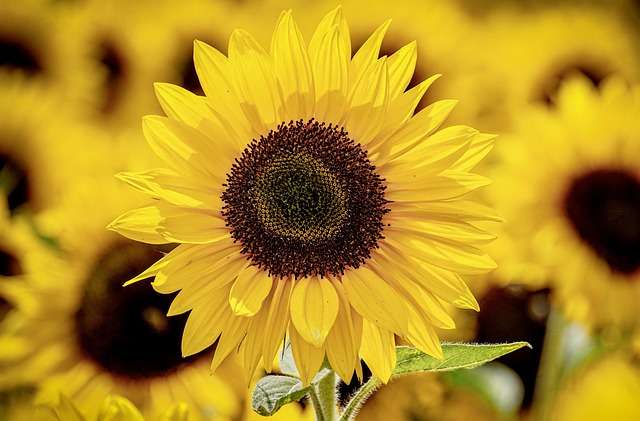Sure! Here are some simple tips for growing mammoth sunflowers from seeds:
1.Choose a sunny spot:
Mammoth sunflowers love sunlight, so pick a spot in your garden that gets plenty of sun throughout the day.
2.Prepare the soil:
Make sure the soil is loose and well-draining. You can mix in some compost or fertilizer to give the seeds a good start.
3.Plant the seeds:
Plant the sunflower seeds about 1 inch deep in the soil, and space them about 6 inches apart. Water them gently after planting.
4.Water regularly:
Keep the soil moist but not waterlogged. Water the seeds regularly, especially during dry spells, but be careful not to overwater.
5.Support the stems:
As the sunflowers grow taller, they might need support to keep them from bending or falling over. You can use stakes or trellises to support the stems.
6.Watch for pests:
Keep an eye out for pests like aphids or slugs that might damage the sunflower plants. If you notice any pests, you can try picking them off by hand or using natural pest control methods.
7.Harvest the seeds:
Once the sunflowers have finished blooming and the seeds are mature, you can harvest them by cutting off the flower heads and letting them dry out. Then, you can remove the seeds and save them for planting next year.
By following these simple tips, you can grow beautiful mammoth sunflowers from seeds in your own garden!
How long do mammoth sunflowers take to bloom?
Mammoth sunflowers usually take about 2 to 3 months to bloom. That means from the time you plant the seeds in the soil, it takes around 60 to 90 days for the sunflowers to grow big and tall and then show their bright, yellow flowers. So, if you plant the seeds in the spring, you can expect to see the big, beautiful blooms by the middle of summer!
When to plant mammoth sunflowers?
You should plant mammoth sunflowers in the springtime, after the last frost has passed and the weather starts to warm up. This is usually around April or May, depending on where you live. Planting them in the spring gives the seeds plenty of time to grow and bloom during the summer months when the weather is nice and sunny. So, when you see the trees budding and the temperatures getting warmer, that’s the perfect time to plant your mammoth sunflower seeds!
how many seeds does a mammoth sunflower produce?
A mammoth sunflower can produce a lot of seeds! Each big flower head can make anywhere from 500 to over 1,000 seeds. That’s a bunch! After the sunflower blooms and the petals fall off, you’ll see the seeds forming in the center of the flower head. These seeds are what you can collect and save for planting next year or for snacking on if you like! So, one mammoth sunflower can give you a whole bunch of seeds to enjoy or share with friends.
What to do with a sunflower when it dies?
When a sunflower dies, you can do a couple of things with it:
1.Harvest the Seeds:
After the flower dies and dries out, you can cut off the flower head and let it finish drying indoors. Once it’s completely dry, you can shake out the seeds and save them for planting next year or for eating as a snack.
2.Compost:
If you don’t want to save the seeds, you can compost the entire sunflower plant. Just cut the dead plant at the base and add it to your compost pile. It will break down over time and become nutrient-rich compost that you can use to fertilize your garden.
Conclusion
In conclusion, mammoth sunflowers can come back every year with proper care and attention. While they are typically annual plants, meaning they complete their life cycle in one growing season, mammoth sunflowers have the potential to reseed themselves or return from seeds collected and replanted by gardeners. In warmer climates, mammoth sunflowers may act more like perennials, surviving the winter and regrowing from the same plant year after year.
However, in colder climates, they may need to be replanted each spring from saved seeds. By collecting and storing the seeds from mature sunflowers and planting them again in the following growing season, gardeners can enjoy the beauty and benefits of mammoth sunflowers year after year. With their tall stature, bright blooms, and abundant seeds, mammoth sunflowers add a cheerful and impressive presence to any garden, making them a popular choice for gardeners looking to attract pollinators, provide food for birds, or simply enjoy their vibrant beauty season after season.
FAQs (Frequently Asked Questions)
1.Can mammoth sunflowers come back every year in colder climates?
In colder climates, the regrowth of mammoth sunflowers can be challenging, but it is possible with proper care and adaptation. Choosing shorter-season varieties and utilizing protective strategies like row covers can enhance their chances of returning annually.
2.How long does it take for mammoth sunflowers to bloom and reseed themselves?
The time it takes for mammoth sunflowers to bloom and reseed themselves varies, but on average, they begin blooming around 70-85 days after germination. Seed production usually follows the blooming phase, taking several weeks to mature.
3.Are there specific fertilizers or nutrients recommended for annual regrowth?
Mammoth sunflowers benefit from fertilizers rich in nitrogen and potassium for optimal growth and blooming. Organic fertilizers, compost, and well-balanced soil amendments can provide the necessary nutrients for their successful regrowth.
4.Is it possible to extend the blooming period of mammoth sunflowers?
By practicing deadheading techniques, providing adequate water and nutrients, and removing any competing plants or weeds, it’s possible to extend the blooming period of mammoth sunflowers. However, it’s important to note that the duration of bloom can vary depending on environmental conditions and the specific variety.
5.What are the potential reasons for my mammoth sunflowers not returning annually?
Several factors may contribute to mammoth sunflowers not returning annually. Poor soil quality, inadequate watering, pest infestations, diseases, and harsh winter conditions can all impact their regrowth. It’s crucial to address these factors and implement appropriate measures to ensure their successful return each year.




1 thought on “Do mammoth sunflowers come back every year? Mammoth sunflower growth 8 stages”